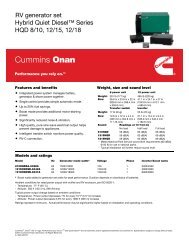Air Brake Manual
Air Brake Manual
Air Brake Manual
You also want an ePaper? Increase the reach of your titles
YUMPU automatically turns print PDFs into web optimized ePapers that Google loves.
· At 90 psi or above, release the spring parking<br />
brakes to prevent compounding the brake<br />
pressure and charge the trailer system by opening<br />
the trailer supply valve. Apply and release the<br />
trailer brakes to ensure they are releasing.<br />
(Failure to release could indicate supply<br />
(emergency) and control (service) lines are<br />
crossed).<br />
· Continue building reservoir air pressure. Check<br />
that the governor places the compressor in the<br />
unloading stage between 115 psi minimum and<br />
135 psi maximum.<br />
· Fan the brake pedal until the pressure drops to<br />
80 psi. Stop fanning to see if the governor has<br />
placed the compressor in the loading stage (the<br />
reading on the air gauge should increase).<br />
· Continue fanning the brake pedal. Warning<br />
device(s) must operate at or before 55 psi and the<br />
trailer supply valve will close at or before 20 psi.<br />
Continue fanning the brake pedal, the spring<br />
parking brake should also apply at or before the<br />
reservoir pressure drops to 20 psi.<br />
· Rebuild reservoir air pressure at fast idle to<br />
between 115 psi minimum and 135 psi maximum.<br />
At 90 psi charge the trailer system by opening the<br />
trailer supply valve.<br />
· Set the tractor spring parking brake (if possible).<br />
Tractor and Trailer Emergency System Check<br />
· Disconnect supply (emergency) line glad hand.<br />
· Trailer brakes should apply immediately.<br />
· There should be no air loss from trailer glad hand.<br />
· <strong>Air</strong> from the tractor should:<br />
(a) stop immediately or,<br />
(b) bleed down no lower than 20 psi and stop.<br />
Note: Under no circumstances should the tractor<br />
pressure drain below 20 psi.<br />
· Reconnect supply (emergency) line and charge<br />
trailer. Rebuild pressure if necessary.<br />
Tractor Protection Valve Check<br />
· Disconnect control (service) line glad hand.<br />
· No air should escape from the tractor or trailer glad<br />
hands.<br />
· Release the spring parking brake.<br />
· Make full brake application. Tractor brakes will<br />
function normally. Trailer service brakes will not<br />
function at all. With brake application maintained, air<br />
will continue to escape from the control (service)<br />
line until air pressure in the reservoirs is depleted to<br />
no lower than 20 psi. The trailer supply and the<br />
tractor protection valve will close and the tractor<br />
and trailer brakes will apply. <strong>Air</strong> loss from control<br />
(service) line will stop.<br />
· Reconnect control (service) line.<br />
Check for Leakage<br />
· Rebuild reservoir air pressure at fast idle to between<br />
115 psi minimum and 135 psi maximum, release the<br />
spring parking brake and charge the trailer at<br />
90 psi.<br />
· Shut off the engine.<br />
· Make a full brake application with the foot valve and<br />
hold. Observe the reservoir air pressure gauge.<br />
· The reading should not drop more than 4 psi per<br />
minute. Lightly tap the gauge to ensure it is not<br />
sticking. For an accurate reading brake application<br />
should be held for at least two minutes.<br />
· Listen for audible air leaks.<br />
· Release full brake application.<br />
74




